Airline and Airport Operations Management: A Comparative Analysis
VerifiedAdded on 2020/07/22
|10
|2285
|121
Report
AI Summary
This report critically evaluates the operational management practices of British Airways (BA) and Easyjet, two major players in the UK airline industry. It explores how these airlines utilize operational management to enhance competitiveness, focusing on key aspects such as supply chain management, quality management, and cost reduction strategies. The report examines BA's implementation of Total Quality Management (TQM), its responses to challenges like economic downturns and customer dissatisfaction, and its efforts to improve service quality through technological advancements and employee training. It also analyzes Easyjet's cost-control measures, point-to-point operations, and strategies for on-time performance. The report highlights the operational challenges faced by both airlines and provides a comparative analysis of their approaches to maximize efficiency and customer satisfaction, drawing conclusions on effective operational strategies in the airline sector. The report uses information from various sources like books, journals, and online sources.
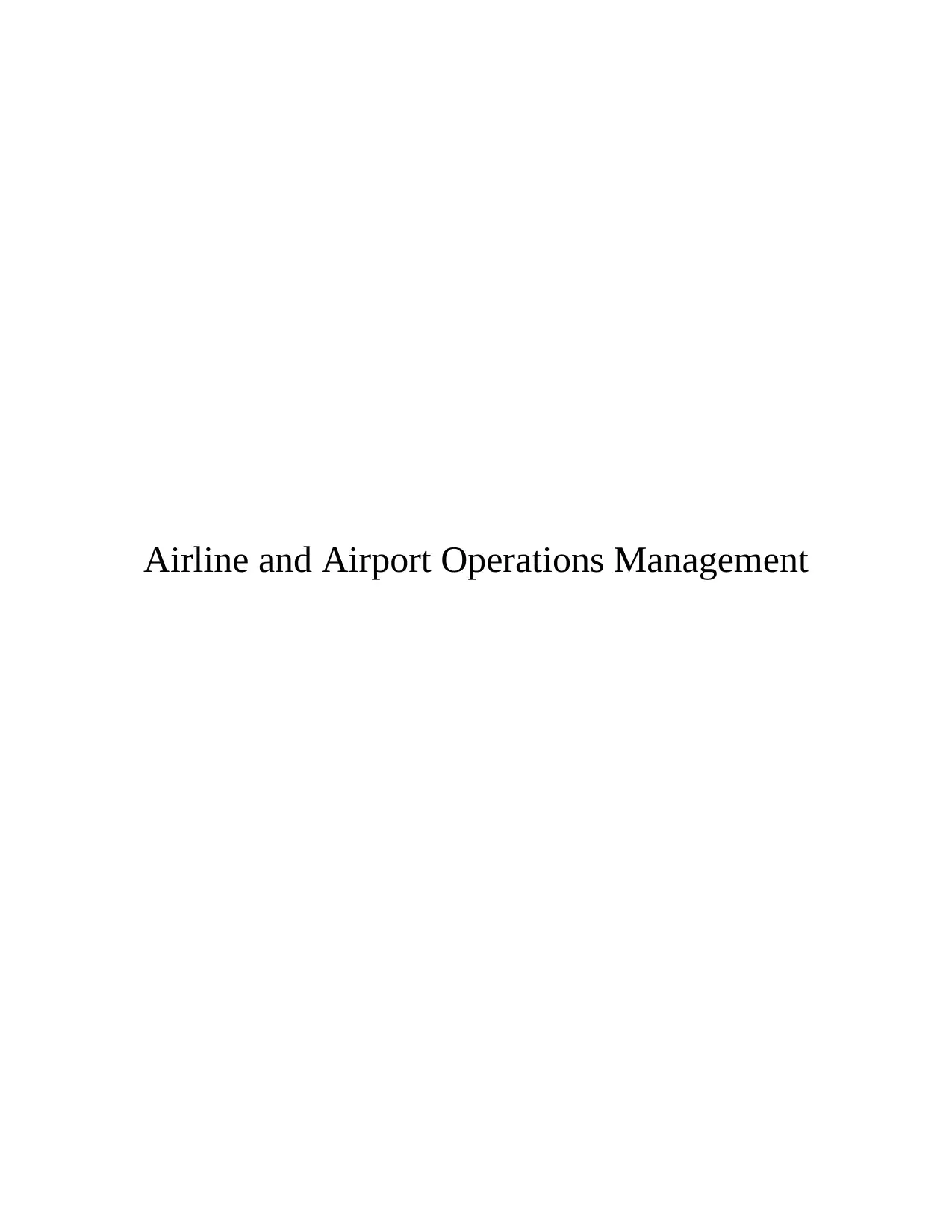
Airline and Airport Operations Management
Paraphrase This Document
Need a fresh take? Get an instant paraphrase of this document with our AI Paraphraser
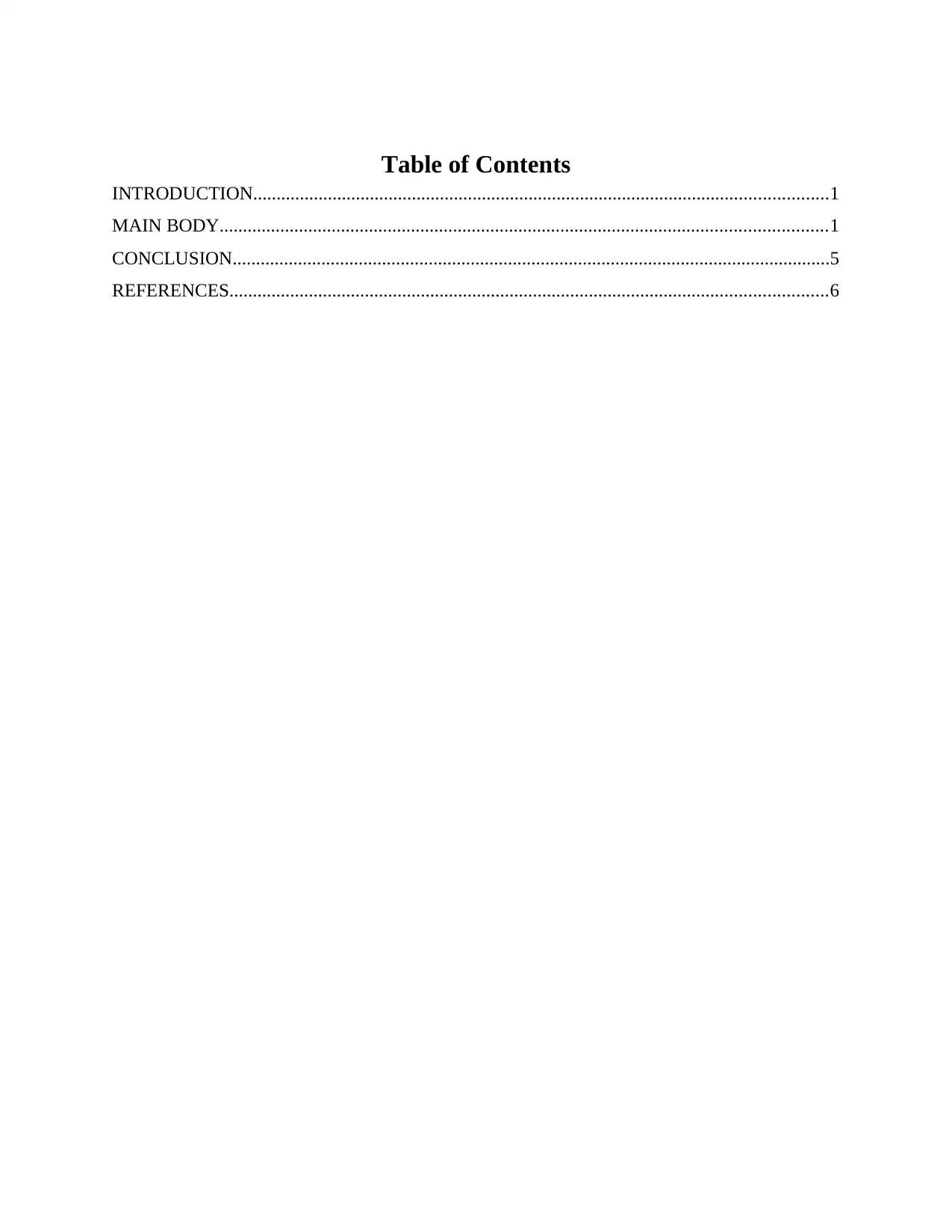
Table of Contents
INTRODUCTION...........................................................................................................................1
MAIN BODY..................................................................................................................................1
CONCLUSION................................................................................................................................5
REFERENCES................................................................................................................................6
INTRODUCTION...........................................................................................................................1
MAIN BODY..................................................................................................................................1
CONCLUSION................................................................................................................................5
REFERENCES................................................................................................................................6
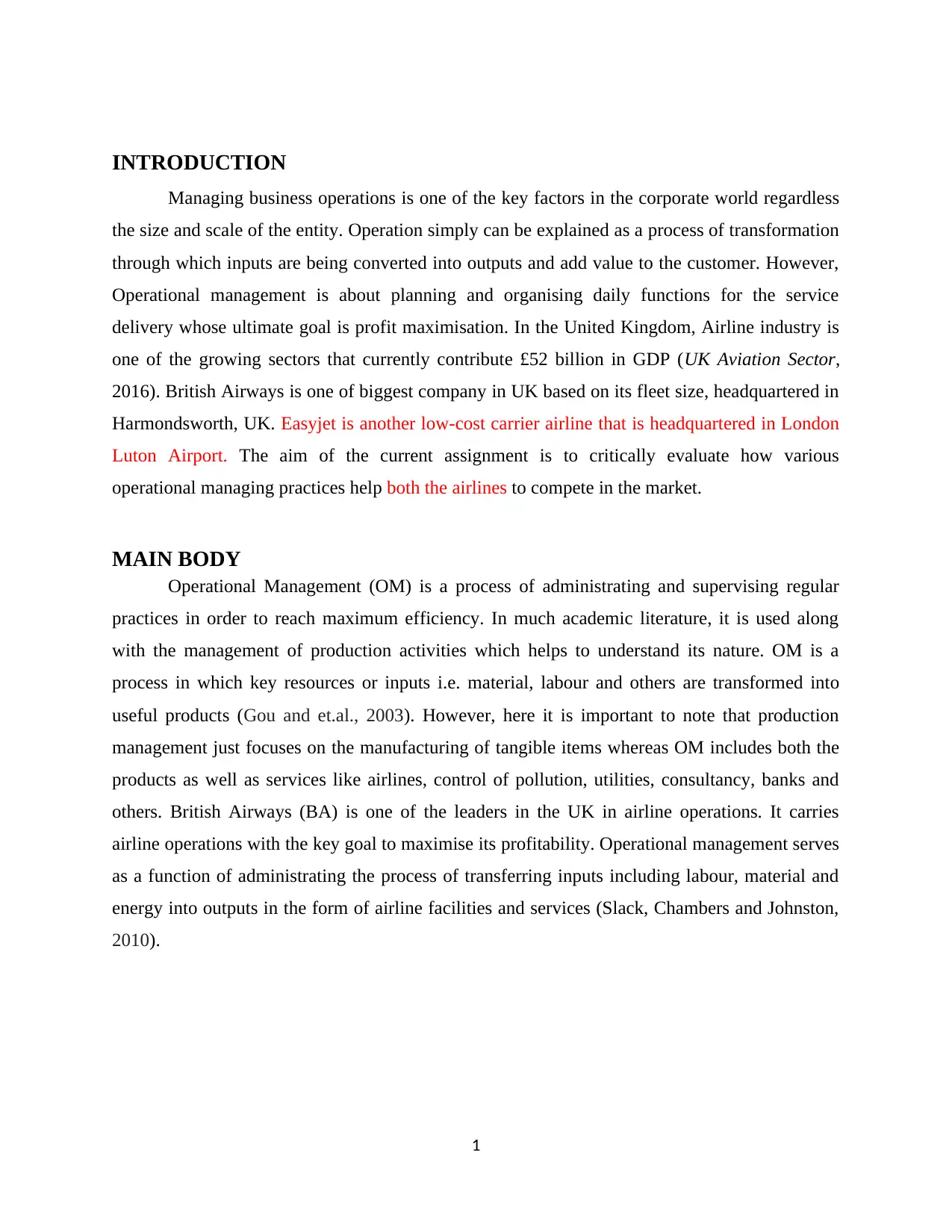
INTRODUCTION
Managing business operations is one of the key factors in the corporate world regardless
the size and scale of the entity. Operation simply can be explained as a process of transformation
through which inputs are being converted into outputs and add value to the customer. However,
Operational management is about planning and organising daily functions for the service
delivery whose ultimate goal is profit maximisation. In the United Kingdom, Airline industry is
one of the growing sectors that currently contribute £52 billion in GDP (UK Aviation Sector,
2016). British Airways is one of biggest company in UK based on its fleet size, headquartered in
Harmondsworth, UK. Easyjet is another low-cost carrier airline that is headquartered in London
Luton Airport. The aim of the current assignment is to critically evaluate how various
operational managing practices help both the airlines to compete in the market.
MAIN BODY
Operational Management (OM) is a process of administrating and supervising regular
practices in order to reach maximum efficiency. In much academic literature, it is used along
with the management of production activities which helps to understand its nature. OM is a
process in which key resources or inputs i.e. material, labour and others are transformed into
useful products (Gou and et.al., 2003). However, here it is important to note that production
management just focuses on the manufacturing of tangible items whereas OM includes both the
products as well as services like airlines, control of pollution, utilities, consultancy, banks and
others. British Airways (BA) is one of the leaders in the UK in airline operations. It carries
airline operations with the key goal to maximise its profitability. Operational management serves
as a function of administrating the process of transferring inputs including labour, material and
energy into outputs in the form of airline facilities and services (Slack, Chambers and Johnston,
2010).
1
Managing business operations is one of the key factors in the corporate world regardless
the size and scale of the entity. Operation simply can be explained as a process of transformation
through which inputs are being converted into outputs and add value to the customer. However,
Operational management is about planning and organising daily functions for the service
delivery whose ultimate goal is profit maximisation. In the United Kingdom, Airline industry is
one of the growing sectors that currently contribute £52 billion in GDP (UK Aviation Sector,
2016). British Airways is one of biggest company in UK based on its fleet size, headquartered in
Harmondsworth, UK. Easyjet is another low-cost carrier airline that is headquartered in London
Luton Airport. The aim of the current assignment is to critically evaluate how various
operational managing practices help both the airlines to compete in the market.
MAIN BODY
Operational Management (OM) is a process of administrating and supervising regular
practices in order to reach maximum efficiency. In much academic literature, it is used along
with the management of production activities which helps to understand its nature. OM is a
process in which key resources or inputs i.e. material, labour and others are transformed into
useful products (Gou and et.al., 2003). However, here it is important to note that production
management just focuses on the manufacturing of tangible items whereas OM includes both the
products as well as services like airlines, control of pollution, utilities, consultancy, banks and
others. British Airways (BA) is one of the leaders in the UK in airline operations. It carries
airline operations with the key goal to maximise its profitability. Operational management serves
as a function of administrating the process of transferring inputs including labour, material and
energy into outputs in the form of airline facilities and services (Slack, Chambers and Johnston,
2010).
1
⊘ This is a preview!⊘
Do you want full access?
Subscribe today to unlock all pages.

Trusted by 1+ million students worldwide
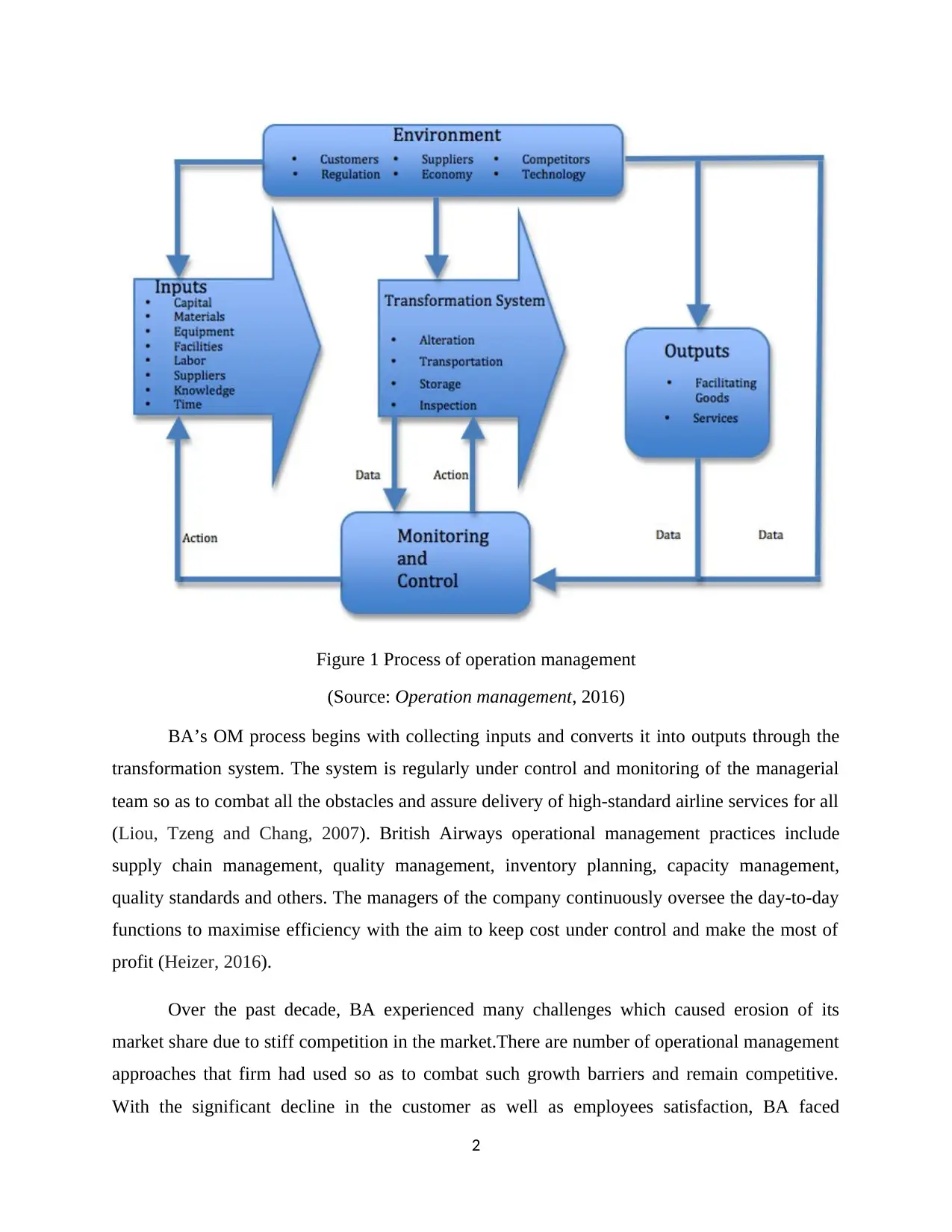
Figure 1 Process of operation management
(Source: Operation management, 2016)
BA’s OM process begins with collecting inputs and converts it into outputs through the
transformation system. The system is regularly under control and monitoring of the managerial
team so as to combat all the obstacles and assure delivery of high-standard airline services for all
(Liou, Tzeng and Chang, 2007). British Airways operational management practices include
supply chain management, quality management, inventory planning, capacity management,
quality standards and others. The managers of the company continuously oversee the day-to-day
functions to maximise efficiency with the aim to keep cost under control and make the most of
profit (Heizer, 2016).
Over the past decade, BA experienced many challenges which caused erosion of its
market share due to stiff competition in the market.There are number of operational management
approaches that firm had used so as to combat such growth barriers and remain competitive.
With the significant decline in the customer as well as employees satisfaction, BA faced
2
(Source: Operation management, 2016)
BA’s OM process begins with collecting inputs and converts it into outputs through the
transformation system. The system is regularly under control and monitoring of the managerial
team so as to combat all the obstacles and assure delivery of high-standard airline services for all
(Liou, Tzeng and Chang, 2007). British Airways operational management practices include
supply chain management, quality management, inventory planning, capacity management,
quality standards and others. The managers of the company continuously oversee the day-to-day
functions to maximise efficiency with the aim to keep cost under control and make the most of
profit (Heizer, 2016).
Over the past decade, BA experienced many challenges which caused erosion of its
market share due to stiff competition in the market.There are number of operational management
approaches that firm had used so as to combat such growth barriers and remain competitive.
With the significant decline in the customer as well as employees satisfaction, BA faced
2
Paraphrase This Document
Need a fresh take? Get an instant paraphrase of this document with our AI Paraphraser
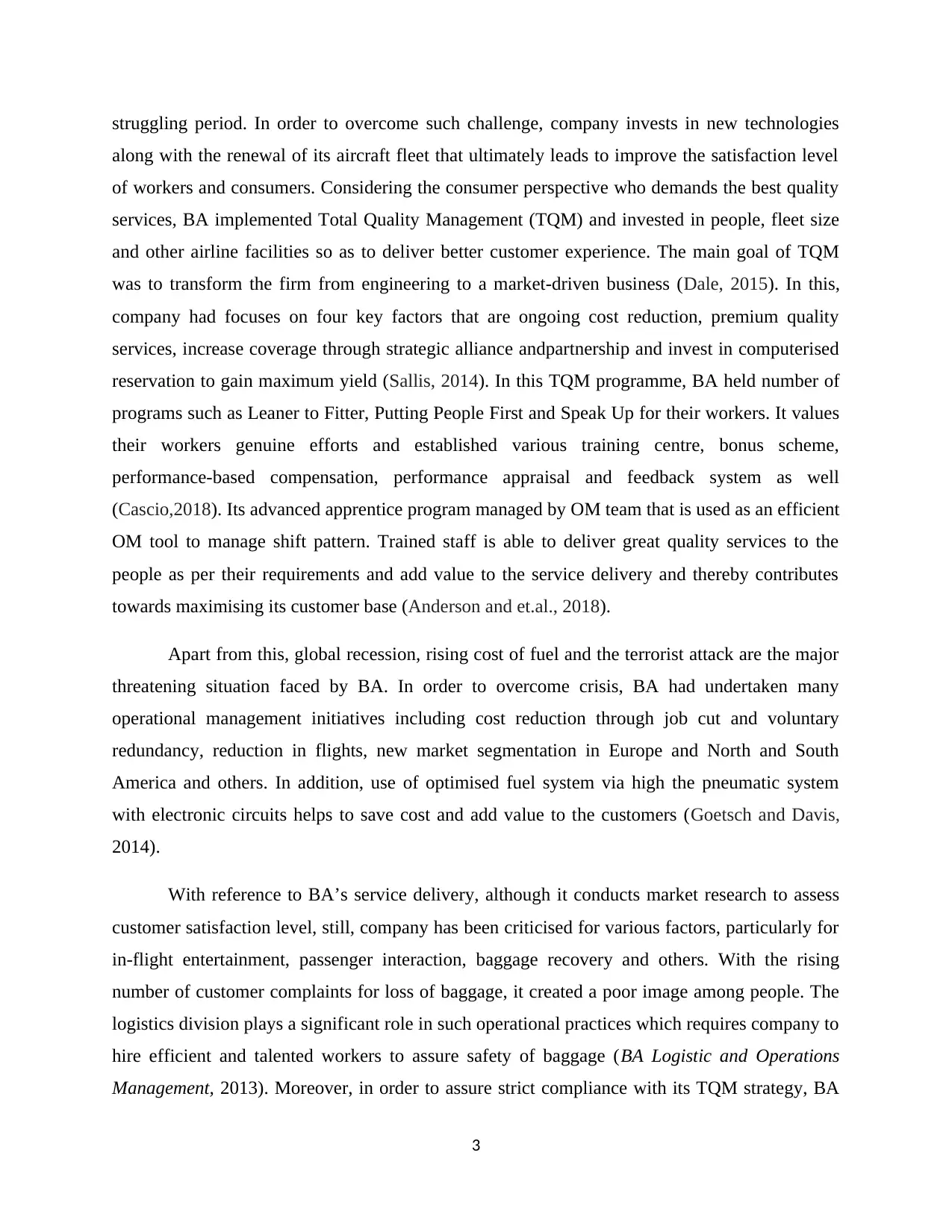
struggling period. In order to overcome such challenge, company invests in new technologies
along with the renewal of its aircraft fleet that ultimately leads to improve the satisfaction level
of workers and consumers. Considering the consumer perspective who demands the best quality
services, BA implemented Total Quality Management (TQM) and invested in people, fleet size
and other airline facilities so as to deliver better customer experience. The main goal of TQM
was to transform the firm from engineering to a market-driven business (Dale, 2015). In this,
company had focuses on four key factors that are ongoing cost reduction, premium quality
services, increase coverage through strategic alliance andpartnership and invest in computerised
reservation to gain maximum yield (Sallis, 2014). In this TQM programme, BA held number of
programs such as Leaner to Fitter, Putting People First and Speak Up for their workers. It values
their workers genuine efforts and established various training centre, bonus scheme,
performance-based compensation, performance appraisal and feedback system as well
(Cascio,2018). Its advanced apprentice program managed by OM team that is used as an efficient
OM tool to manage shift pattern. Trained staff is able to deliver great quality services to the
people as per their requirements and add value to the service delivery and thereby contributes
towards maximising its customer base (Anderson and et.al., 2018).
Apart from this, global recession, rising cost of fuel and the terrorist attack are the major
threatening situation faced by BA. In order to overcome crisis, BA had undertaken many
operational management initiatives including cost reduction through job cut and voluntary
redundancy, reduction in flights, new market segmentation in Europe and North and South
America and others. In addition, use of optimised fuel system via high the pneumatic system
with electronic circuits helps to save cost and add value to the customers (Goetsch and Davis,
2014).
With reference to BA’s service delivery, although it conducts market research to assess
customer satisfaction level, still, company has been criticised for various factors, particularly for
in-flight entertainment, passenger interaction, baggage recovery and others. With the rising
number of customer complaints for loss of baggage, it created a poor image among people. The
logistics division plays a significant role in such operational practices which requires company to
hire efficient and talented workers to assure safety of baggage (BA Logistic and Operations
Management, 2013). Moreover, in order to assure strict compliance with its TQM strategy, BA
3
along with the renewal of its aircraft fleet that ultimately leads to improve the satisfaction level
of workers and consumers. Considering the consumer perspective who demands the best quality
services, BA implemented Total Quality Management (TQM) and invested in people, fleet size
and other airline facilities so as to deliver better customer experience. The main goal of TQM
was to transform the firm from engineering to a market-driven business (Dale, 2015). In this,
company had focuses on four key factors that are ongoing cost reduction, premium quality
services, increase coverage through strategic alliance andpartnership and invest in computerised
reservation to gain maximum yield (Sallis, 2014). In this TQM programme, BA held number of
programs such as Leaner to Fitter, Putting People First and Speak Up for their workers. It values
their workers genuine efforts and established various training centre, bonus scheme,
performance-based compensation, performance appraisal and feedback system as well
(Cascio,2018). Its advanced apprentice program managed by OM team that is used as an efficient
OM tool to manage shift pattern. Trained staff is able to deliver great quality services to the
people as per their requirements and add value to the service delivery and thereby contributes
towards maximising its customer base (Anderson and et.al., 2018).
Apart from this, global recession, rising cost of fuel and the terrorist attack are the major
threatening situation faced by BA. In order to overcome crisis, BA had undertaken many
operational management initiatives including cost reduction through job cut and voluntary
redundancy, reduction in flights, new market segmentation in Europe and North and South
America and others. In addition, use of optimised fuel system via high the pneumatic system
with electronic circuits helps to save cost and add value to the customers (Goetsch and Davis,
2014).
With reference to BA’s service delivery, although it conducts market research to assess
customer satisfaction level, still, company has been criticised for various factors, particularly for
in-flight entertainment, passenger interaction, baggage recovery and others. With the rising
number of customer complaints for loss of baggage, it created a poor image among people. The
logistics division plays a significant role in such operational practices which requires company to
hire efficient and talented workers to assure safety of baggage (BA Logistic and Operations
Management, 2013). Moreover, in order to assure strict compliance with its TQM strategy, BA
3
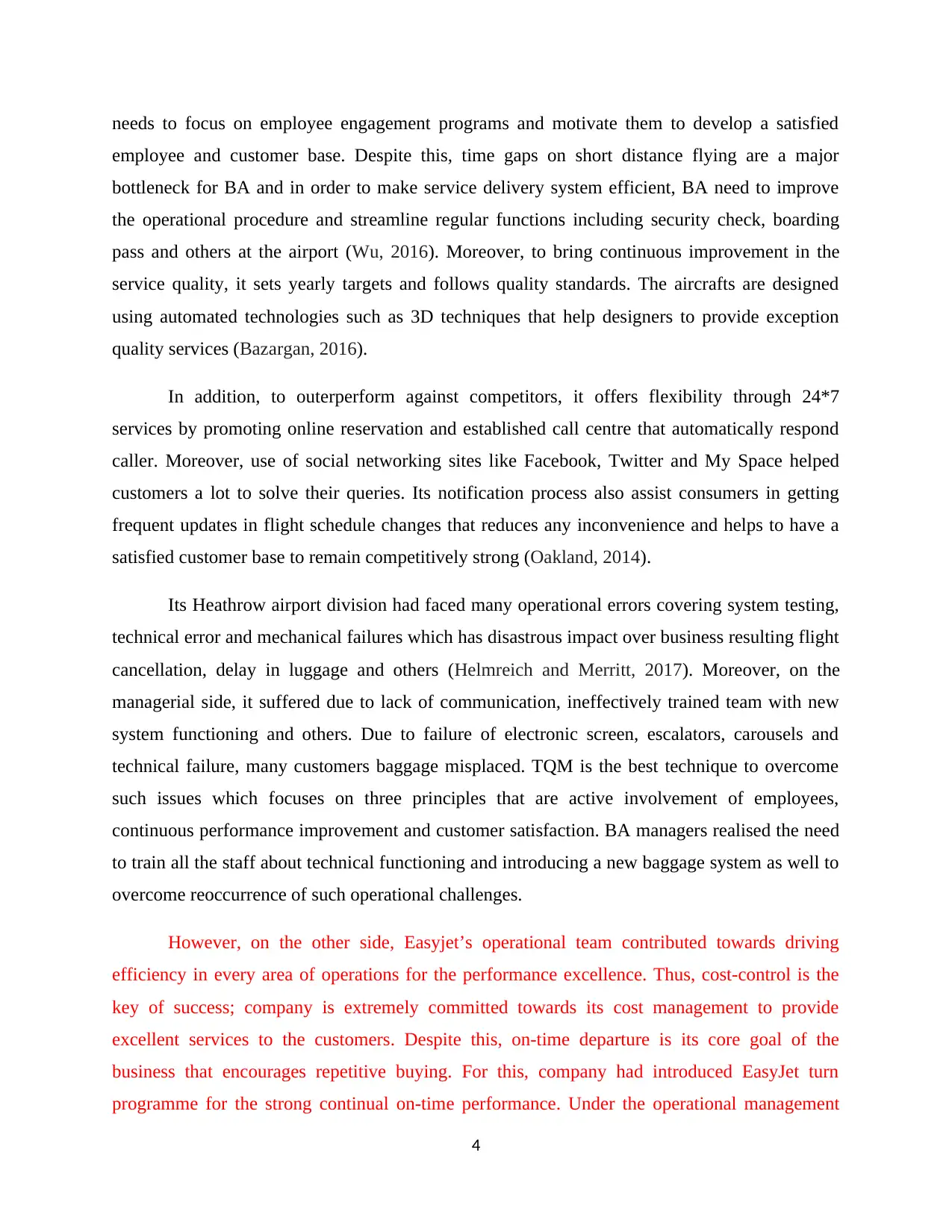
needs to focus on employee engagement programs and motivate them to develop a satisfied
employee and customer base. Despite this, time gaps on short distance flying are a major
bottleneck for BA and in order to make service delivery system efficient, BA need to improve
the operational procedure and streamline regular functions including security check, boarding
pass and others at the airport (Wu, 2016). Moreover, to bring continuous improvement in the
service quality, it sets yearly targets and follows quality standards. The aircrafts are designed
using automated technologies such as 3D techniques that help designers to provide exception
quality services (Bazargan, 2016).
In addition, to outerperform against competitors, it offers flexibility through 24*7
services by promoting online reservation and established call centre that automatically respond
caller. Moreover, use of social networking sites like Facebook, Twitter and My Space helped
customers a lot to solve their queries. Its notification process also assist consumers in getting
frequent updates in flight schedule changes that reduces any inconvenience and helps to have a
satisfied customer base to remain competitively strong (Oakland, 2014).
Its Heathrow airport division had faced many operational errors covering system testing,
technical error and mechanical failures which has disastrous impact over business resulting flight
cancellation, delay in luggage and others (Helmreich and Merritt, 2017). Moreover, on the
managerial side, it suffered due to lack of communication, ineffectively trained team with new
system functioning and others. Due to failure of electronic screen, escalators, carousels and
technical failure, many customers baggage misplaced. TQM is the best technique to overcome
such issues which focuses on three principles that are active involvement of employees,
continuous performance improvement and customer satisfaction. BA managers realised the need
to train all the staff about technical functioning and introducing a new baggage system as well to
overcome reoccurrence of such operational challenges.
However, on the other side, Easyjet’s operational team contributed towards driving
efficiency in every area of operations for the performance excellence. Thus, cost-control is the
key of success; company is extremely committed towards its cost management to provide
excellent services to the customers. Despite this, on-time departure is its core goal of the
business that encourages repetitive buying. For this, company had introduced EasyJet turn
programme for the strong continual on-time performance. Under the operational management
4
employee and customer base. Despite this, time gaps on short distance flying are a major
bottleneck for BA and in order to make service delivery system efficient, BA need to improve
the operational procedure and streamline regular functions including security check, boarding
pass and others at the airport (Wu, 2016). Moreover, to bring continuous improvement in the
service quality, it sets yearly targets and follows quality standards. The aircrafts are designed
using automated technologies such as 3D techniques that help designers to provide exception
quality services (Bazargan, 2016).
In addition, to outerperform against competitors, it offers flexibility through 24*7
services by promoting online reservation and established call centre that automatically respond
caller. Moreover, use of social networking sites like Facebook, Twitter and My Space helped
customers a lot to solve their queries. Its notification process also assist consumers in getting
frequent updates in flight schedule changes that reduces any inconvenience and helps to have a
satisfied customer base to remain competitively strong (Oakland, 2014).
Its Heathrow airport division had faced many operational errors covering system testing,
technical error and mechanical failures which has disastrous impact over business resulting flight
cancellation, delay in luggage and others (Helmreich and Merritt, 2017). Moreover, on the
managerial side, it suffered due to lack of communication, ineffectively trained team with new
system functioning and others. Due to failure of electronic screen, escalators, carousels and
technical failure, many customers baggage misplaced. TQM is the best technique to overcome
such issues which focuses on three principles that are active involvement of employees,
continuous performance improvement and customer satisfaction. BA managers realised the need
to train all the staff about technical functioning and introducing a new baggage system as well to
overcome reoccurrence of such operational challenges.
However, on the other side, Easyjet’s operational team contributed towards driving
efficiency in every area of operations for the performance excellence. Thus, cost-control is the
key of success; company is extremely committed towards its cost management to provide
excellent services to the customers. Despite this, on-time departure is its core goal of the
business that encourages repetitive buying. For this, company had introduced EasyJet turn
programme for the strong continual on-time performance. Under the operational management
4
⊘ This is a preview!⊘
Do you want full access?
Subscribe today to unlock all pages.

Trusted by 1+ million students worldwide
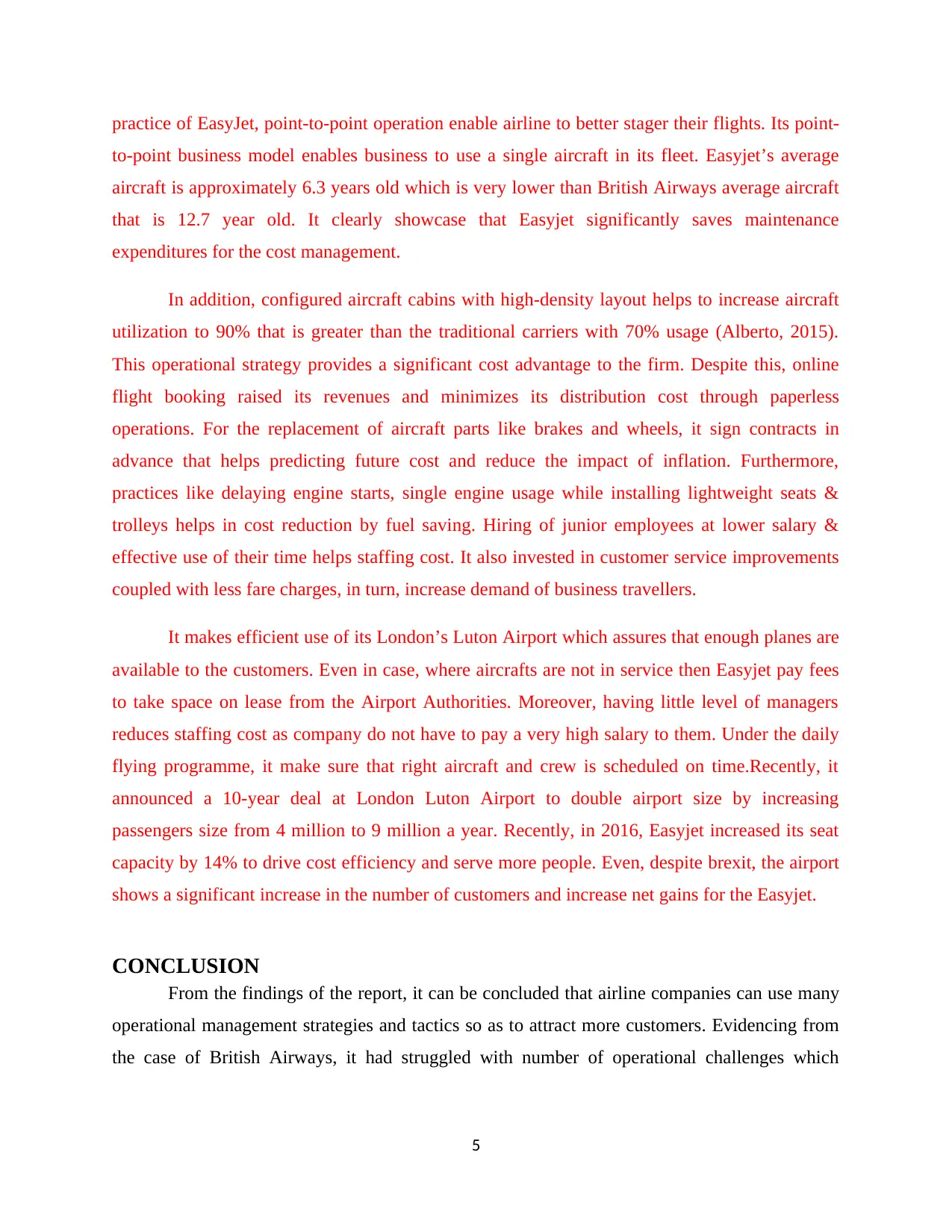
practice of EasyJet, point-to-point operation enable airline to better stager their flights. Its point-
to-point business model enables business to use a single aircraft in its fleet. Easyjet’s average
aircraft is approximately 6.3 years old which is very lower than British Airways average aircraft
that is 12.7 year old. It clearly showcase that Easyjet significantly saves maintenance
expenditures for the cost management.
In addition, configured aircraft cabins with high-density layout helps to increase aircraft
utilization to 90% that is greater than the traditional carriers with 70% usage (Alberto, 2015).
This operational strategy provides a significant cost advantage to the firm. Despite this, online
flight booking raised its revenues and minimizes its distribution cost through paperless
operations. For the replacement of aircraft parts like brakes and wheels, it sign contracts in
advance that helps predicting future cost and reduce the impact of inflation. Furthermore,
practices like delaying engine starts, single engine usage while installing lightweight seats &
trolleys helps in cost reduction by fuel saving. Hiring of junior employees at lower salary &
effective use of their time helps staffing cost. It also invested in customer service improvements
coupled with less fare charges, in turn, increase demand of business travellers.
It makes efficient use of its London’s Luton Airport which assures that enough planes are
available to the customers. Even in case, where aircrafts are not in service then Easyjet pay fees
to take space on lease from the Airport Authorities. Moreover, having little level of managers
reduces staffing cost as company do not have to pay a very high salary to them. Under the daily
flying programme, it make sure that right aircraft and crew is scheduled on time.Recently, it
announced a 10-year deal at London Luton Airport to double airport size by increasing
passengers size from 4 million to 9 million a year. Recently, in 2016, Easyjet increased its seat
capacity by 14% to drive cost efficiency and serve more people. Even, despite brexit, the airport
shows a significant increase in the number of customers and increase net gains for the Easyjet.
CONCLUSION
From the findings of the report, it can be concluded that airline companies can use many
operational management strategies and tactics so as to attract more customers. Evidencing from
the case of British Airways, it had struggled with number of operational challenges which
5
to-point business model enables business to use a single aircraft in its fleet. Easyjet’s average
aircraft is approximately 6.3 years old which is very lower than British Airways average aircraft
that is 12.7 year old. It clearly showcase that Easyjet significantly saves maintenance
expenditures for the cost management.
In addition, configured aircraft cabins with high-density layout helps to increase aircraft
utilization to 90% that is greater than the traditional carriers with 70% usage (Alberto, 2015).
This operational strategy provides a significant cost advantage to the firm. Despite this, online
flight booking raised its revenues and minimizes its distribution cost through paperless
operations. For the replacement of aircraft parts like brakes and wheels, it sign contracts in
advance that helps predicting future cost and reduce the impact of inflation. Furthermore,
practices like delaying engine starts, single engine usage while installing lightweight seats &
trolleys helps in cost reduction by fuel saving. Hiring of junior employees at lower salary &
effective use of their time helps staffing cost. It also invested in customer service improvements
coupled with less fare charges, in turn, increase demand of business travellers.
It makes efficient use of its London’s Luton Airport which assures that enough planes are
available to the customers. Even in case, where aircrafts are not in service then Easyjet pay fees
to take space on lease from the Airport Authorities. Moreover, having little level of managers
reduces staffing cost as company do not have to pay a very high salary to them. Under the daily
flying programme, it make sure that right aircraft and crew is scheduled on time.Recently, it
announced a 10-year deal at London Luton Airport to double airport size by increasing
passengers size from 4 million to 9 million a year. Recently, in 2016, Easyjet increased its seat
capacity by 14% to drive cost efficiency and serve more people. Even, despite brexit, the airport
shows a significant increase in the number of customers and increase net gains for the Easyjet.
CONCLUSION
From the findings of the report, it can be concluded that airline companies can use many
operational management strategies and tactics so as to attract more customers. Evidencing from
the case of British Airways, it had struggled with number of operational challenges which
5
Paraphrase This Document
Need a fresh take? Get an instant paraphrase of this document with our AI Paraphraser

overcome through the application of TQM, IT advancement, staff training, cost reduction
initiatives, service quality standards and continuous improvement.
6
initiatives, service quality standards and continuous improvement.
6
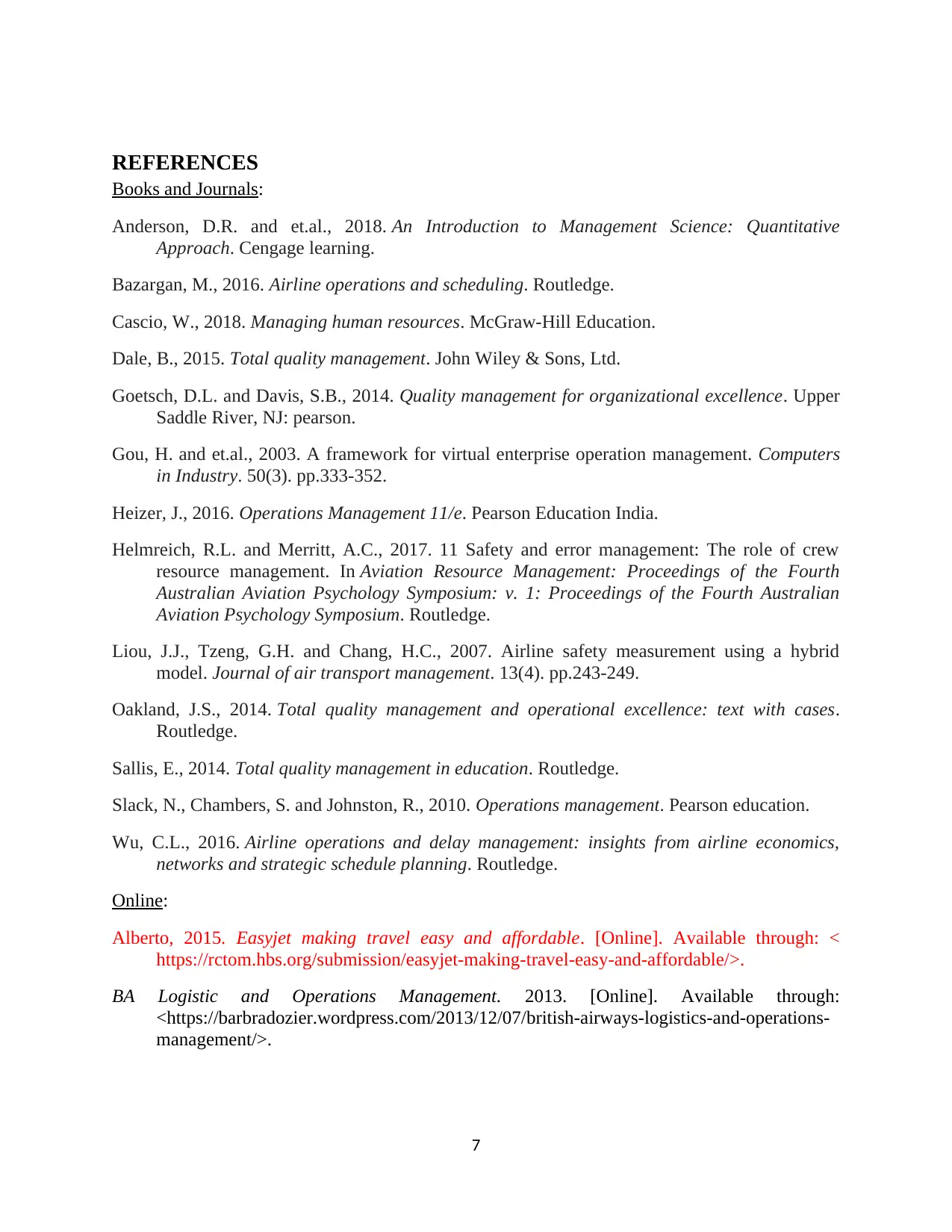
REFERENCES
Books and Journals:
Anderson, D.R. and et.al., 2018. An Introduction to Management Science: Quantitative
Approach. Cengage learning.
Bazargan, M., 2016. Airline operations and scheduling. Routledge.
Cascio, W., 2018. Managing human resources. McGraw-Hill Education.
Dale, B., 2015. Total quality management. John Wiley & Sons, Ltd.
Goetsch, D.L. and Davis, S.B., 2014. Quality management for organizational excellence. Upper
Saddle River, NJ: pearson.
Gou, H. and et.al., 2003. A framework for virtual enterprise operation management. Computers
in Industry. 50(3). pp.333-352.
Heizer, J., 2016. Operations Management 11/e. Pearson Education India.
Helmreich, R.L. and Merritt, A.C., 2017. 11 Safety and error management: The role of crew
resource management. In Aviation Resource Management: Proceedings of the Fourth
Australian Aviation Psychology Symposium: v. 1: Proceedings of the Fourth Australian
Aviation Psychology Symposium. Routledge.
Liou, J.J., Tzeng, G.H. and Chang, H.C., 2007. Airline safety measurement using a hybrid
model. Journal of air transport management. 13(4). pp.243-249.
Oakland, J.S., 2014. Total quality management and operational excellence: text with cases.
Routledge.
Sallis, E., 2014. Total quality management in education. Routledge.
Slack, N., Chambers, S. and Johnston, R., 2010. Operations management. Pearson education.
Wu, C.L., 2016. Airline operations and delay management: insights from airline economics,
networks and strategic schedule planning. Routledge.
Online:
Alberto, 2015. Easyjet making travel easy and affordable. [Online]. Available through: <
https://rctom.hbs.org/submission/easyjet-making-travel-easy-and-affordable/>.
BA Logistic and Operations Management. 2013. [Online]. Available through:
<https://barbradozier.wordpress.com/2013/12/07/british-airways-logistics-and-operations-
management/>.
7
Books and Journals:
Anderson, D.R. and et.al., 2018. An Introduction to Management Science: Quantitative
Approach. Cengage learning.
Bazargan, M., 2016. Airline operations and scheduling. Routledge.
Cascio, W., 2018. Managing human resources. McGraw-Hill Education.
Dale, B., 2015. Total quality management. John Wiley & Sons, Ltd.
Goetsch, D.L. and Davis, S.B., 2014. Quality management for organizational excellence. Upper
Saddle River, NJ: pearson.
Gou, H. and et.al., 2003. A framework for virtual enterprise operation management. Computers
in Industry. 50(3). pp.333-352.
Heizer, J., 2016. Operations Management 11/e. Pearson Education India.
Helmreich, R.L. and Merritt, A.C., 2017. 11 Safety and error management: The role of crew
resource management. In Aviation Resource Management: Proceedings of the Fourth
Australian Aviation Psychology Symposium: v. 1: Proceedings of the Fourth Australian
Aviation Psychology Symposium. Routledge.
Liou, J.J., Tzeng, G.H. and Chang, H.C., 2007. Airline safety measurement using a hybrid
model. Journal of air transport management. 13(4). pp.243-249.
Oakland, J.S., 2014. Total quality management and operational excellence: text with cases.
Routledge.
Sallis, E., 2014. Total quality management in education. Routledge.
Slack, N., Chambers, S. and Johnston, R., 2010. Operations management. Pearson education.
Wu, C.L., 2016. Airline operations and delay management: insights from airline economics,
networks and strategic schedule planning. Routledge.
Online:
Alberto, 2015. Easyjet making travel easy and affordable. [Online]. Available through: <
https://rctom.hbs.org/submission/easyjet-making-travel-easy-and-affordable/>.
BA Logistic and Operations Management. 2013. [Online]. Available through:
<https://barbradozier.wordpress.com/2013/12/07/british-airways-logistics-and-operations-
management/>.
7
⊘ This is a preview!⊘
Do you want full access?
Subscribe today to unlock all pages.

Trusted by 1+ million students worldwide
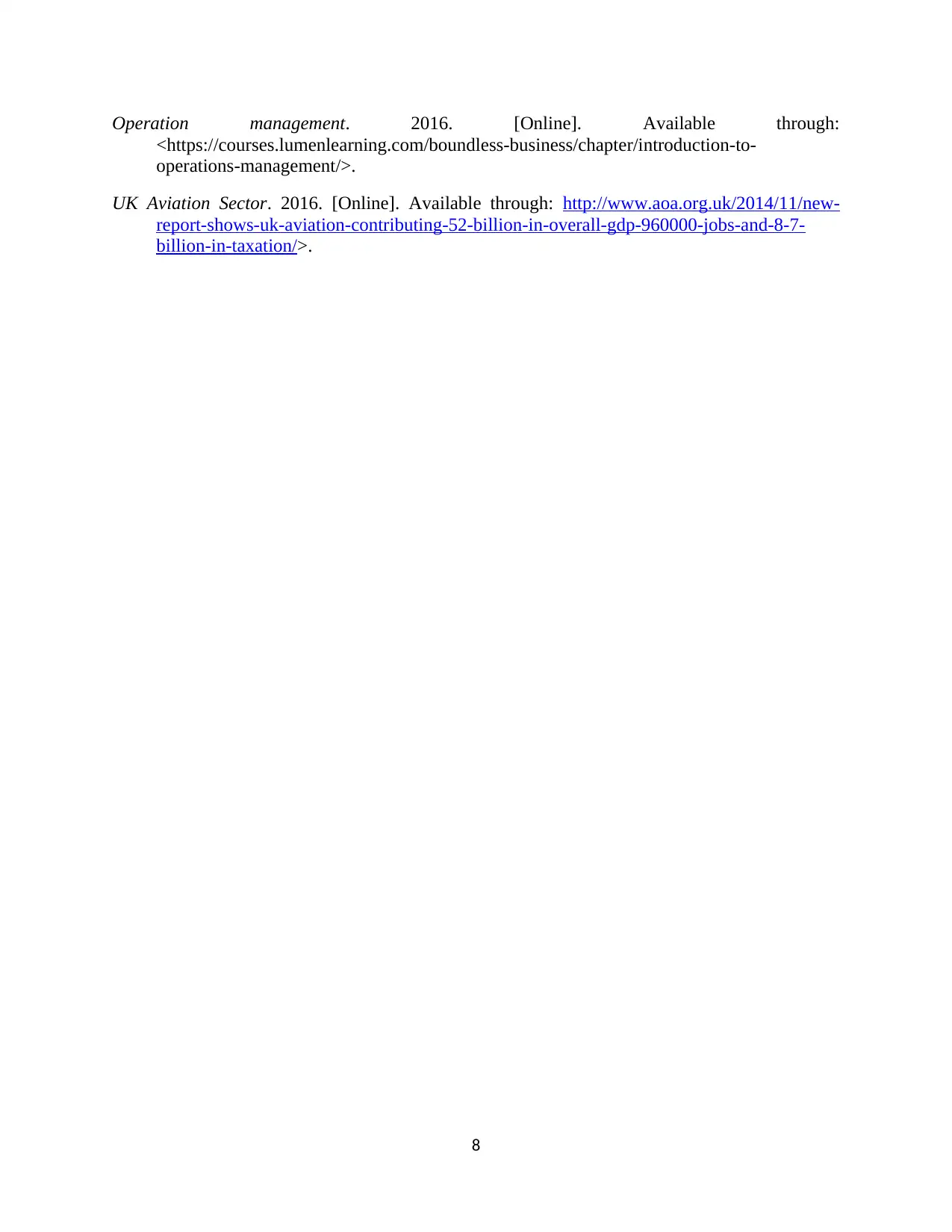
Operation management. 2016. [Online]. Available through:
<https://courses.lumenlearning.com/boundless-business/chapter/introduction-to-
operations-management/>.
UK Aviation Sector. 2016. [Online]. Available through: http://www.aoa.org.uk/2014/11/new-
report-shows-uk-aviation-contributing-52-billion-in-overall-gdp-960000-jobs-and-8-7-
billion-in-taxation/>.
8
<https://courses.lumenlearning.com/boundless-business/chapter/introduction-to-
operations-management/>.
UK Aviation Sector. 2016. [Online]. Available through: http://www.aoa.org.uk/2014/11/new-
report-shows-uk-aviation-contributing-52-billion-in-overall-gdp-960000-jobs-and-8-7-
billion-in-taxation/>.
8
1 out of 10
Related Documents
Your All-in-One AI-Powered Toolkit for Academic Success.
+13062052269
info@desklib.com
Available 24*7 on WhatsApp / Email
![[object Object]](/_next/static/media/star-bottom.7253800d.svg)
Unlock your academic potential
Copyright © 2020–2025 A2Z Services. All Rights Reserved. Developed and managed by ZUCOL.



